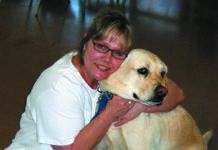

Q Sassy, age six, has had a constant problem “back there” and goes to the vet frequently to have her glands expressed. Within a week she is scooting again and licking her behind. The vet suggested adding more fiber to her food, but her bowel movements are not soft. What to do?
Gary Thomas
Houston, Texas
Dear Mr. Thomas,
A There are a couple of different routes you can take to solve Sassy’s problem. But first, a (very) short anatomy lesson.
Dogs have two anal glands, which sit at 5 and 7 o’clock to the anus. They produce a fluid whose purpose is uncertain, but it is believed to give a dog’s excrement a characteristic odor that other dogs find interesting, or which they use to identify something about that particular dog; dogs learn each other largely by sniffing.
The odiferous fluid is called anal sac fluid, and it normally passes from the anal sacs each time a dog voids. The pressure of pushing out the waste does the trick because the anal sacs sit in the anal sphincter, which contracts upon defecation.
But in some dogs, the tiny, narrow duct through which the fluid leaves the sacs becomes plugged. It’s called an impacted anal sac in veterinary terms, and a dog will find it uncomfortable. Often, a veterinarian can express the fluid by putting a finger up the rectum and squeezing the sac until the liquid comes out. But if a dog repeatedly has the problem, as Sassy does, another solution is called for. There are several possible routes to take.
One is to give a dog a high-fiber diet, as Sassy’s vet recommended. Its purpose is not to make stools softer, or to change their texture in any other way, but to add volume to them so that they have a better chance of pressing out the fluid. There’s no scientific proof that it works, but it’s a reasonable concept and an easy enough thing to try.
If more fiber doesn’t solve the problem, you can learn to express the anal sacs yourself, so you don’t have to keep running to Sassy’s doctor’s office.
Or, you can have the sacs surgically removed. They are not necessary anatomy. The operation is relatively simple, taking 30 to 45 minutes. It’s best to get a veterinarian experienced in the procedure. Some veterinarians are uncomfortable with the procedure out of concern that if they remove too much of the anal sphincter while removing the sacs themselves, fecal incontinence can result. This is highly unlikely to happen if an experienced vet performs the surgery.
Note: based on clinical observations, little dogs, like Sassy, are more prone to having impacted anal sacs than larger ones.





